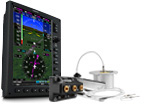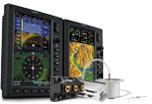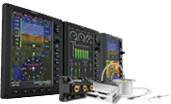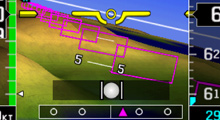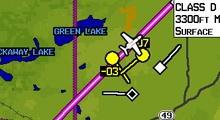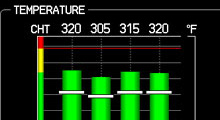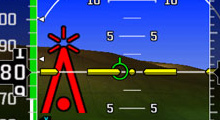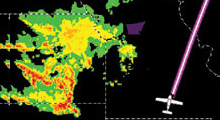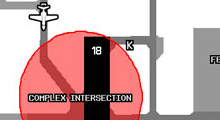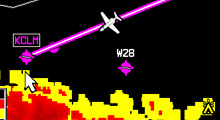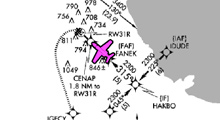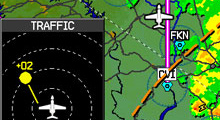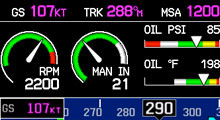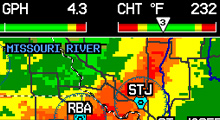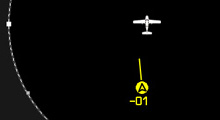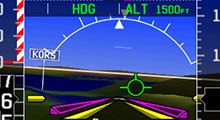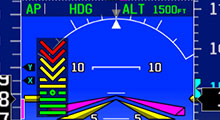Please note the information below is for the legacy G3X system. For information on Garmin's new G3X Touch, click here.
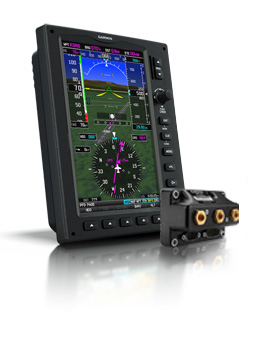
Live the Suite Life
All the capabilities you want in a true “glass cockpit” are brought together in the G3X flight display system. Designed specifically for experimental/kitplane and light sport panels, this scalable system lets you grow as your needs and budget allow. This easy-to-install suite can contain up to three redundant PFD/MFD configurable displays, all of which contain a built-in GPS and big, bright sunlight readable 7" high-resolution WVGA screen. The G3X provides full primary flight display (PFD) attitude/directional guidance along with electronic engine gauges, terrain/obstacles alerting, geo-referenced FliteCharts® and SafeTaxi® airport diagrams. Optional SiriusXM® weather, ADS-B “In” with traffic and weather, ADS-B “Out” transponder, and angle of attack sensor can all be added easily. An affordable Garmin autopilot system is also available with advanced features like coupled approaches and auto-trim, as well as flight director, indicated air speed hold and straight and level button when installed with an optional control panel. You can choose a single- or multi-display configuration with separate PFD and MFD displays — or you can even add a third co-pilot’s display, if desired.
One System. Many Solutions.
The integration and versatility provided by the G3X electronic flight displays makes it easy to customize the ideal panel layout for your aircraft. You can start with a single display — or use as many as three displays — to fit the space, avionics stack, and budget available. Shown here are just a few examples of what’s possible and practical in a G3X installation.
The versatile G3X panel-mount glass displays work like building blocks, allowing you to grow your system to fit your needs and budget. You can start with a single display that combines full primary flight (PFD) attitude/directional guidance with electronic engine monitoring and moving-map multifunction (MFD) capabilities.
Want a two-screen flight deck layout with separate PFD and MFD displays? That’s an easy upgrade with G3X. You get a large-format attitude and heading display, paired with your moving map and engine gauge data. A built-in Garmin network interface allows for full reversionary capability on either screen.
For the ultimate in non-certified glass cockpit suites, this configuration adds a third display for the co-pilot’s position. The Garmin network interface allows for a maximum of three displays to be interlinked in your panel. You can use it as an optional second MFD to display even more data at once — like dedicated engine information and moving map.
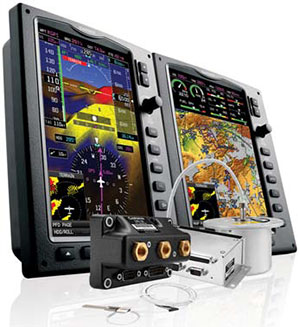
Hardware
Combine Simplicity with Sophistication The multi-tasking Garmin displays that comprise your G3X suite are scaled to fit the panels (and price ranges) of most experimental/kitbuilt and light sport aircraft. Each display features a big 7" high-resolution WVGA screen, built-in high-sensitivity WAAS GPS receiver, rotary joystick cursor control for data entry, redundant power inputs, and soft keys for mode selection. There’s a front-loading SD™ card slot for easy updating of software and databases. Plus, a built-in aviation basemap helps provide realistic visual reference — identifying cities, roads, rivers, lakes and other guide points. You can choose topographic VFR or airway-style IFR map modes. And there’s also a built-in terrain elevation database that uses color-coding to alert you as you approach potentially hazardous terrain. Both overhead and vertical profile views of this data are graphically depicted on the terrain page. The backbone of the G3X Touch system is the same tried-and-true sensor technology as the G3X. In fact, you can upgrade from the G3X to the G3X Touch with just a few alterations to your existing panel and wiring. Each easy-to-read display features a 10.6" high-resolution WVGA screen with infrared touchscreen technology with a large touchpint that that ensures precise inputs and minimizes inadvertent touches – even with gloves. LED indicators make it easy to tell when sensors have been correctly connected and flexible mounting options allow the GSU 25 ADAHRS to be mounted either on back of the display or remotely. A front-loading SD™ card slot makes it easy to update software and databases. The aviation basemap helps provide realistic visual reference — identifying cities, roads, rivers, lakes and other guide points. You can choose topographic VFR or airway-style IFR map modes. And there’s also a built-in terrain elevation database that uses color-coding to alert you as you approach potentially hazardous terrain. Both overhead and vertical profile views of this information is graphically depicted on the terrain page.
- 1 or more displays (with or without XM/SiriusXM weather capability)
- Air Data, Attitude and Heading Reference System (ADAHRS)
- Magnetometer, which determines the aircraft’s magnetic heading
- Outside air temperature probe
- Engine Indication System (EIS) interface (engine sensor kits sold separately)
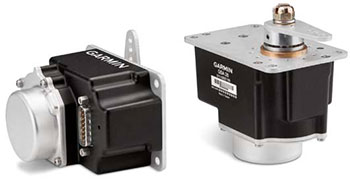
Integrated Autopilot
Add an Affordable AFCS
All it takes is the addition of Garmin’s affordable GSA 28 “smart” servo units to give your G3X a range of autopilot capabilities similar to those provided by the high-end GFC™700 systems found on thousands of certified aircraft. You have the option of purchasing 1 servo (roll only), or 2 servos (pitch + roll) to add the level of capability you want. Even better, the Garmin system includes automatic trim functionality at no additional cost. And for added redundancy, it’s the only integrated autopilot in its class to offer standalone operation in the event of EFIS display outage or shutdown. The optional GMC 305 control panel is a dedicated interface unit that provides advanced autopilot modes like indicated airspeed hold, independent flight director, and third axis yaw damper (when installed with appropriate servos). A control wheel integrated into the GMC 305 makes for easier pitch, vertical speed and airspeed adjustments. Plus, for added safety, the panel’s advanced LVL mode button commands automatic recovery from steep or unusual attitudes — enabling the autopilot to return your aircraft to straight-and-level flight. Installation of the system is simple and straightforward, with industry-standard servo mounting kits available — as well as airframe-specific versions for the popular Van’s RV series (RV-4/6/7/8/9/10 models).
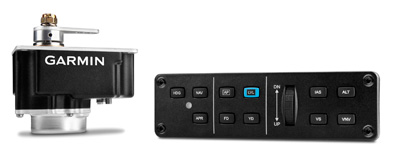
Autopilot Options for G3X
Single-axis Configured with 1 GSA 28 integrated servo for roll only autopilot Dual-axis Configured with 2 GSA 28 integrated servo units for pitch and roll autopilot Optional GMC 305 Control Panel A separate autopilot control panel for dedicated mode selection, as well as access to additional autopilot modes including Indicated Airspeed Hold (IAS), Level Recovery (LVL), and Yaw Damper (YD).
Features
See the Big Picture


